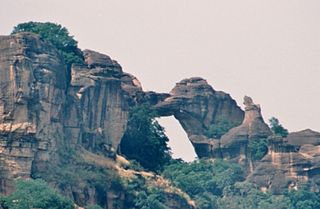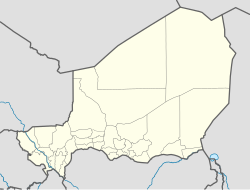
The regions of Niger are subdivided into 63 departments. Before the devolution program on 1999–2005, these departments were styled arrondissements. Confusingly, the next level up (regions) had, before 2002-2005 been styled departments. Prior to a revision in 2011, there had been 36 departments. A draft law in August 2011 would expand that number to 63. Until 2010, arrondissements remained a proposed subdivision of departments, though none were used. The decentralisation process, begun in the 1995-1999 period replaced appointed Prefects at Departmental or Arrondissement level with elected councils, first elected in 1999. These were the first local elections held in the history of Niger. Officials elected at commune level are then selected as representatives at Departmental, regional, and National level councils and administration. The Ministry of Decentralisation was created to oversee this task, and to create a national consultative council of local officials.

Tahoua is one of eight Regions of Niger. The capital of the region is the commune of Tahoua. The region covers 106,677 km².

The Gao Region is a region in northeastern Mali. The capital city is Gao.

Siby is a village and rural commune in the Cercle of Kati in the Koulikoro Region of southern Mali. The commune contains 21 villages and in the 2009 census had a population of 26,632. The village lies 50 km southwest of the capital, Bamako, on the plain to the south of the Monts Mandingues. The RN5 road that links Bamako with Siguiri in Guinea runs through the village.

The Departments of Niger are subdivided into communes. As of 2005, in the seven Regions and one Capital Area, there were 36 départements, divided into 265 communes, 122 cantons and 81 groupements. The latter two categories cover all areas not covered by Urban Communes or Rural Communes, and are governed by the Department, whereas Communes have elected councils and mayors. Additional semi-autonomous sub-divisions include Sultanates, Provinces and Tribes (tribus). The Nigerien government estimates there are an additional 17000 Villages administered by Rural Communes, while there are over 100 Quartiers administered by Urban Communes.
Bouza is a town in southwestern Niger. A town of eight thousand, it is the administrative center of Bouza Department, part of Tahoua Region.

Niger is divided into eight regions, each of which is named after its capital.

Bouza is a department of the Tahoua Region in Niger. Its capital lies at the city of Bouza, and also includes the town of Déoulé. As of 2011, the department had a total population of 386,093 people.

Keita is a department of the Tahoua Region in Niger. Its capital lies at the city of Keita. The Keita Department is located in the centre of the Republic of Niger and covers an area of more than 4,860 km2 characterised by plateaux with rocky slopes and valleys forming a complex system of watersheds exposed to strong winds and water erosion. The sahelian climate with an average temperature about of 29 °C, a short rainy season and a yearly average rainfall between 400 and 500 mm, represents one of the most limiting factors.
Akoubounou, or Akabinu in the local Tin Sert language, is a village located in the west to the town of Abalak, in the Tahoua Region of Niger.
Keita is a town and commune in Niger. It is the capital of the Keita Department, within the Tahoua Region, and has a population of 10,631 as of 2012.

Niger is governed through a four layer, semi-decentralised series of Administrative divisions. Begun 1992, and finally approved with the formation of the Fifth Republic of Niger on 18 July 1999, Niger has been enacting a plan for Decentralisation of some state powers to local bodies. Prior to the 1999-2006 project, Niger's subdivisions were administered via direct appointment from the central government in Niamey. Beginning with Niger's first municipal elections of 2 February 1999, the nation started electing local officials for the first time. Citizens now elect local committee representatives in each Commune, chosen by subdivisions of the commune: "Quarters" in towns and "Villages" in rural areas, with additional groupings for traditional polities and nomadic populations. These officials choose Mayors, and from them are drawn representatives to the Department level. The Departmental council, Prefect, and representatives to the Regional level are chosen here using the same procedure. The system is repeated a Regional level, with a Regional Prefect, council, and representatives to the High Council of Territorial Collectives. The HCCT has only advisory powers, but its members have some financial, planning, educational and environmental powers. The central government oversees this process through the office of the Minister of State for the Interior, Public Safety and Decentralization.

Diafarabé is a village and rural commune of the Cercle of Ténenkou in the Mopti Region of Mali. The commune is at the southern boundary of the cercle. It covers an area of approximately 980 square kilometers and extends on both sides of the Niger River. The commune includes 10 villages and in the 2009 census had a population of 15,748. The main village of Diafarabé, the chef-lieu, is situated on the north bank of the river next to the junction with the Diaka Channel, a distributary that only flows when the Niger is in flood.
Illela, Niger is a town and urban commune in Niger.
Abala, Niger is a village and rural commune in Niger.
Tamaske is a city and rural commune in Niger. It is located in the Keita Department, in the Tahoua Region.
Tarka, Niger is a village and rural commune in Niger. It is located in the Belbédji Departement of the Zinder Region. As of 2010 the commune had a population of 86,695.

Tassara is a village and rural commune in Niger.
Torodi is a small town and a rural commune in Niger. As a rural center, Torodi hosts a large weekly market and the seat of local tribal authority (canton). Torodi is in the Say Department of the Tillaberi Region, which surrounds the national capital, Niamey. Say Department, with its capital at the large Niger River town of Say, abuts Niamey to the southwest and across the river to the west. The town of Torodi lies about 60 km due west of the city of Say and 50 km east of the border with Burkina Faso. Torodi itself lies on a tributary of the Niger, the Gourbi river.
Yaouri is a village and rural commune in Matameye Department in Niger.








